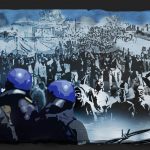The casspir haunts our present
The purchase of casspirs, always a tool of colonial domination, to contain land occupations and road blockades in Durban offers a deeply disturbing insight into the state of the nation.
Author:
11 February 2019

In the 1980s, the yellow casspir became an iconic – and global – symbol of oppression as the apartheid state mobilised increasingly militarised forms of force to try and crush the rebellion raging in townships and land occupations across the country.
The first casspirs were built in a factory in Germiston in 1980 and painted olive green. They were used, most infamously, by the notorious Koevoet “counterinsurgency” unit of the South West African Police in northern Namibia. Then minister of law and order Louis le Grange described Koevoet, which was modelled after the Rhodesian Selous Scouts special forces regiment, as “the crowbar, which prises terrorists out of the bushveld like nails from rotten wood”. It boasted of a “kill rate” of 25:1.
The casspirs, in a hideous mechanised echo of the dogs on the trail of escaped slaves, were used to crash through the bush while hunting down anticolonial guerrillas. Their use was soon extended to the war in Angola. In 1986, a Swapo guerrilla, injecting himself with amphetamines to stay awake, covered almost 400km on foot in five days with casspirs in pursuit.
Related article:
Casspirs have continued to be used in colonial wars ever since, including by American forces in Iraq and Afghanistan. Neill Blomkamp’s 2009 film, District 9, imagined them back on the streets of Johannesburg, this time carrying aliens. But while the aliens were a fiction in the service of metaphor, casspirs had not been contained to apartheid. They have been used to police impoverished black people in Johannesburg since at least 2002, when they were sent into Thembelihle, adjacent to Lenasia in south Johannesburg, in an attempt to bring the Landless People’s Movement to heel.
When protests erupted on the streets of Ferguson in Missouri, United States, in August 2014 after the police murder of Michael Brown, casspirs, brought home from Iraq, were used on American streets.
In geographic terms, Ferguson is a long way from Germiston. But the route travelled by the casspir from a factory in Germiston to the streets of Ferguson, via colonial wars in Angola and Iraq, and the urban insurrection in South Africa that first put them on television screens across the planet, has a precise and consistent political logic.
The casspir is not a tank designed to go into battle against other tanks. It is a tool of colonial domination designed to be used in circumstances where access to military hardware is fundamentally unequal and where people, rather than rival armies, are the enemy. The casspir is designed so that its occupants can shoot through small holes at people outside without any risk of being hit by a brick, a petrol bomb or a bullet.
The city as future battleground
In Vietnam, Algeria and Angola, colonial war was often waged outside the cities – in jungles, mountains and savannah. Today, the American military is well aware that the conflicts of the future will be fought, whether at home or abroad, in the cities. In South Africa, the urban land occupation has become the most intense and sustained site of conflict between the state and impoverished people.
From the Paris Commune of 1871 to the struggle over water in Cochabamba, Bolivia, in 2000 and the escalating urban land occupations in South Africa, the barricade has been a central tactic when people find that they must confront police and soldiers in the city.
Related article:
The term strike has its origins in the rebellions of 17th-century sailors, who struck by taking down the sails of the ships on which they were subjected to forced labour. Today, many people in South Africa understand it to refer primarily to the organisation of a road blockade. Across much of the world, the burning tyre has come to mark the insurgent politics of impoverished people.
The casspir has kept pace with political developments. The latest iteration comes with a large scoop at the front to push through the road blockades pulled together by people without money, who make their politics from the detritus of the city.
At the end of January, the eThekwini Municipality took delivery of three of the four casspirs it has ordered, at a cost of just under R24 million. They are to police what the municipality, a fundamentally corrupt and violent institution, describes as “service delivery protests” and “land invasions”. In a sickening turn of phrase, deputy mayor Fawzia Peer told the media that she was “elated” at their arrival.
Colonial question
From Durban to Ferguson, the urban question in the settler colony is, fundamentally, a colonial question. Frantz Fanon lays this out clearly in the opening pages of The Wretched of the Earth, affirms that the urban land occupation in “the forbidden quarters” is an insurgent move against the logic of colonialism and offers an explicitly spatial metric for decolonisation.
The eThekwini Municipality is hardly alone in its failure to address the urban question, or the way in which it has continued to govern impoverished black people through modes of power that are animated by a fundamentally colonial logic. But the situation in Durban has acquired a particularly intensity in two respects.
It is the only city in South Africa in which a sustained movement, with tens of thousands of members, has developed, rooted itself in land occupations and explicitly set itself against the colonial logic that continues to shape the allocation and management of urban land. The scale of the violence that has been mobilised against impoverished black people in this city, whether organised or not, through the various kinds of armed force available to the local state and party structures is also unique.
The national and municipal police forces, the Anti-Land Invasion Unit, private security and the izinkabi (assassins) mobilise routine and escalating forms of violence, frequently lethal, to sustain the duopoly of the state and the market over the allocation of urban land. When the casspirs arrived in the city, Abahlali baseMjondolo were correct to declare that “the ANC is militarising repression in Durban”.
New hulking tool
The casspir was designed to be used against particular kinds of people, in particular contexts. It is, and always has been, a tool of colonial domination exclusively deployed against racialised people.
In 2014, images of these hulking tools of colonial war on the streets of Ferguson became part of the milieu that shaped the emergence of the Black Lives Matter movement, which influenced aspects of the student movement that erupted in South Africa the following year.
Five years later, the arrival of the new casspirs in Durban marks a collapse into openly colonial forms of policing urban contestation. The casspirs may have gone from khaki to yellow to white, and been redesigned from use in the bush to use in the cities, but they are intended to be put to the same fundamental purpose for which they were first designed by the apartheid state in 1980.
The failure on the part of the ANC to generate a democratic vision for our cities has been profound.
Peer’s enthusiasm for the return of the casspir, a decidedly unfriendly ghost from our past, said a lot more about the state of the nation than President Cyril Ramaphosa’s anodyne speech in Parliament.


